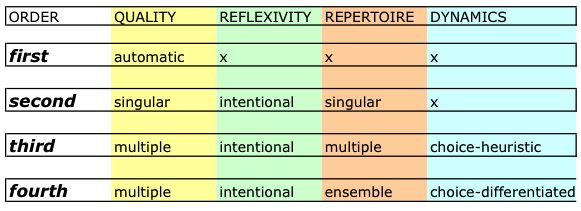Reflexive Orders of Awareness – A Schema

Some examples should suffice to unpack the notion of reflexive orders.
First Order awareness is automatic, and not directed. If you ever have driven a car and noted at some point that you ‘were on automatic,’ and then been amazed at this lack of consciousness about being a driver, you’re recalling what it feels like to be on automatic, in, as-it-were, First Order awareness. “I barely remember consciously driving to work today! I was thinking about something else, pre-occupied.”
Second Order awareness adds to this awareness of what you are doing. A good example is learning how to ride a bike, where–at the beginning–the new rider has to consciously turn against the tilt out of balance. This is conscious attention paid to what you are doing. This awareness has a very narrow focus. It’s not optional.
Third Order awareness adds to this additional modes for awareness. In the example of driving, this means what else you might do, be aware of, while driving. I term this choice heuristic to reflect how multiple modes are balanced by knowing their prior dynamic via experience. Acquired rules of thumb facilitate this balancing act. For example, some drivers figure out how to have cell phone conversations while driving, and balance attention to this with attention to driving.
Fourth Order awareness adds to this an ability to choose modes of awareness by virtue of having made a prior coherent differentiation of available modes and their effective differential application. The difference between Third/Fourth Order phases is a matter of degree, yet the hallmark of Fourth Order is this critical differentiation. This would acknowledge, for example, that driving while phoning incurs a probalistic downside.
Fourth Order awareness basically means: being able to match awareness with optimal requirements for effective deployment of awareness. And, do this from a coherent ensemble of choices for being aware. And, be able to explain what one does to both differentiate and select.
Finally, to complete this model, (or schema,) there are mediating and liminal phases between the orders. There is a good example of this. Emotional intelligence, itself a repertoire for meeting the goal requirements of an interpersonal interaction, exists at the beginning of conscious development of one’s own intelligent responsiveness. At the beginning it exists as a choice-heuristic. Later this develops into choice-differentiated; thus moves choice from being the result of a rule of thumb to being the result of very particular, and in some ways formal, differentiation of optimal choice. Such a choice is made from a coherent ensemble, i.e. repertoire.
Yet, this move is sometimes articulated in a fuzzy move between Third and Fourth Order. One feature is common to Fourth order awareness. It instantiates motivation to search out more effective and possibly optimal modes of awareness. In other words, there is a gain to be realized in expanding one’s ensemble of choices. So, one is not satisfied with only the repertoire of “rules of thumb.”
This can be further understood, when stretched between the entire First-to-Fourth range, as making the move from automatic, knee-jerk responses to responses forged from being able to make a conscious selection from a repertoire of possible responses. Given this sense, the move from Third Order to Fourth Order selection procedures reflects a substantial enhancement and individuation of critical consciousness.
Again, differentiation and individuation imply here the ability to explain why one choice is superior to some other choice.
We’ll move next, in a follow-up post, to examples and applications in both negative and positive terms, and we’ll use the current environment of political discourse to do so.
